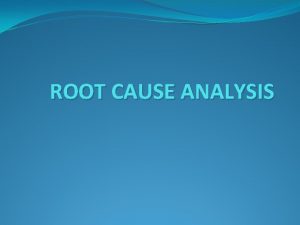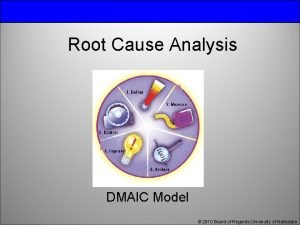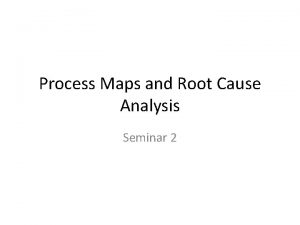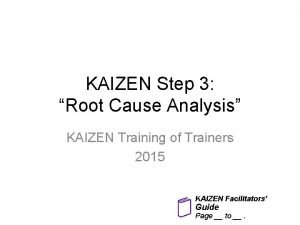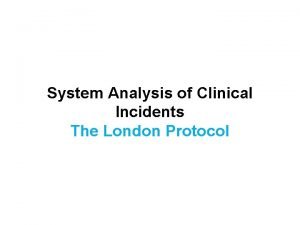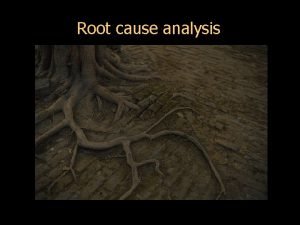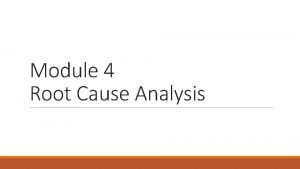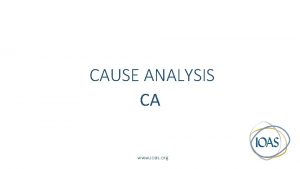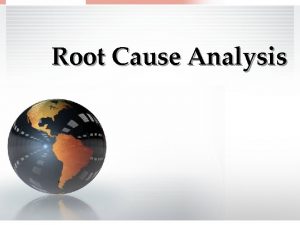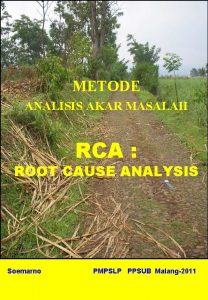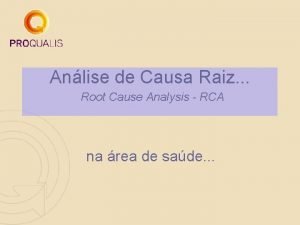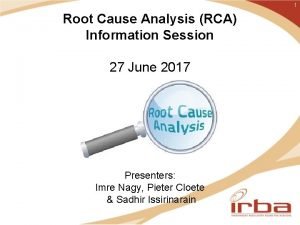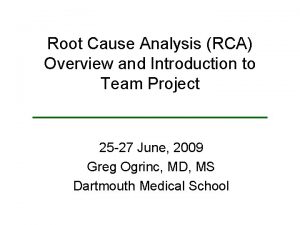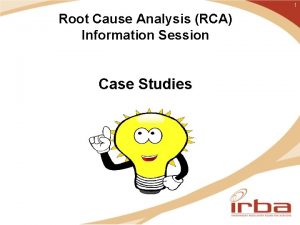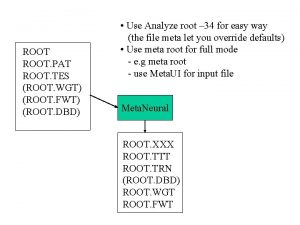ROOT CAUSE ANALYSIS RCA www ioas org What













- Slides: 13

ROOT CAUSE ANALYSIS RCA www. ioas. org

What do you know about RCA? • A tool for systematic investigation and analysis • Reactive analysis • Incident investigation – may apply to losses, failure, inefficiencies • What went wrong? What were the causes? What changes should be made? • Root cause analysis helps identify what, how and why something happened, thus preventing recurrence. • Diving deep to find the source of the problem - to avoid addressing just the symptom. • Root causes are underlying factors, are reasonably identifiable, can be controlled and allow for generation of recommendations. • Various techniques may be used. www. ioas. org

Root causes • Root causes are specific underlying causes. • Root causes are those that can reasonably be identified. • Root causes are those management has control to fix. • Root causes are those for which effective recommendations for preventing recurrences can be generated. www. ioas. org

Inspector uses wrong version of the inspection form… • The typical investigation would probably conclude “inspector error” was the cause, inform the inspector and give him the right form. • But if the analysis stops here, it has not probed deeply enough to understand the reasons for the mistake. • Not enough is known to prevent it from occurring again or to be sure it is not a widespread problem. www. ioas. org

There may be more than 1 root cause of a problem… www. ioas. org

Many methodologies are employed in RCA Complex • Failure Modes and Effects Analysis (FMEA) • Causal factor charting • Statistical data analysis • Fishbone or Ishikawa diagram Simple • Five Whys • May incorporate simple techniques from complex analysis • simple cause and effect maps • fishbone diagrams www. ioas. org

5 Whys Problem Root cause(s) www. ioas. org Corrective actions

Why did the inspector use the wrong form? • It was the only form he had. He has always used that form, no one ever commented. • Why did he have only that form? • The inspector manager did not provide inspectors with the revised versions. • Why did the inspector manager not provide inspectors with revised versions? • She doesn’t make the revisions. She doesn’t see reports. She didn’t know it was necessary. She never thought about it. • Why did she not think about it? • Not part of her training, job description, work instructions or procedures. www. ioas. org

The inspector has been using the wrong form for years. Why was this not caught? • The review team did not know it was important. • Why did they not know it was important? • Use of current forms is not part of their training, was never mentioned before and they have no control over what the inspector does anyway. • Why? www. ioas. org

In addition to asking why writing it down may help the analysis. Not noticed by reviewers Wrong form Inspector has old forms www. ioas. org Didn’t know it was important Didn’t have authority Manager did not know

Fishbone diagram Had only old forms Unaware of changes No one noticed Reviewers not trained No one responsible Unable to access current formats Inspector uses wrong form Cause 3 Cause 4 www. ioas. org

5 Whys rules of thumb • State the problem clearly. • 5 is the number at which most root causes are clearly identified. • Do not worry about not meeting or exceeding 5 Whys. • Follow your thought process to decide how many Why’s you need to get to the point where the root cause is evident. • This is an investigative process. You don’t need to answer all Whys at once. • The outcome of 5 Whys (or other analysis) is a root cause, not the resolution. • Corrective actions and effectiveness verification follow. www. ioas. org

www. ioas. org
 Root cause analysis sop
Root cause analysis sop Root cause analysis esempi
Root cause analysis esempi Dmiac
Dmiac M&m fishbone diagram
M&m fishbone diagram Fishbone diagram kaizen
Fishbone diagram kaizen Analisa akar masalah
Analisa akar masalah London protocol root cause analysis
London protocol root cause analysis Fishbone diagram
Fishbone diagram 4p root cause analysis
4p root cause analysis Root cause analysis tutorial
Root cause analysis tutorial Sentinel event vs near miss
Sentinel event vs near miss Jefferson memorial root cause analysis
Jefferson memorial root cause analysis Rischio clinico slide
Rischio clinico slide Jefferson memorial root cause analysis
Jefferson memorial root cause analysis

